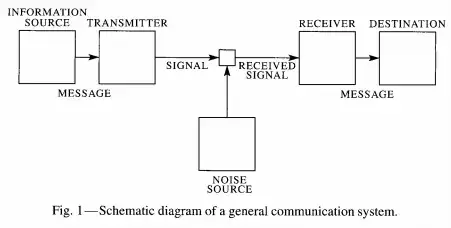What we mean by "information" started in the seminal paper by Claude Shannon,
A mathematical theory of communication. Shannon gave a generalized picture
of communication which is shown schematically in Fig. 1 of this paper
(reproduced below) and consists of effectively three stages; a sender and
receiver (traditionally named Alice and Bob), and a physical medium or channel
over which the intended information is transmitted between Alice and Bob.

Alice must encode the intended information onto some physical medium that can
be transmitted to Bob. This stage is the fundamental stage of abstracting or
symbolically representing meaning. Language is a natural example of this. In
speech a specific idea is represented by a specific sound or grouping of
sounds, while in written language the representation of the idea is in the form
of visual characters or symbols. In general, ideas are represented in some
physical form that can be transmitted and ultimately experienced or sensed by
another person. Each physical symbol is chosen from a set of distinct possible
symbols with pre-agreed upon meanings. Note, this process is inherently
discrete given the requirement of having a countable number of possible
pre-agreed upon messages (i.e. a pre-agreed upon language/alphabet)!
So in the general communication scheme of the figure above, Alice translates
the intended message into a series of abstract symbols. Each symbol is encoded
onto the state of the physical medium in one of a number of different possible
configurations. The list of possible configurations or symbols $x\in \mathbb X$
is called the alphabet, in analogy with written communication. The information
$I(X)$ of a random symbol $X$ with $N$ equally likely possible values
$x\in\mathbb X$ is defined to be
$$I(X) = \log_b(N).$$
The logarithmic measure of information is chosen because the number of distinct
possible messages generally grows exponentially with resources. For example if
a message contains $n$ independent random symbols $X$, each chosen from an
alphabet of size $N$, then the total number of possible combinations of
sequences is $N^n$, and the amount of information contained in this sequence is
$$I(X^n) = \log_b(N^n)=n\log_b(N) = n I(X).$$
It should be noted that information as defined above is only defined to within
a constant, which is equivalent to the freedom to choose the base $b$ of the
logarithm which defines the units of information. If the natural logarithm is
chosen then information is given by nats, if base 10 is chosen the
information given is in Hartleys, and of course if base two is chosen then
the information is in the familiar bits.
The second piece of the puzzle comes from Shannon's Noisy-channel coding
theorem. This theorem establishes that for any physical channel there is a
maximum rate of discrete data that can be encoded, even if the physical medium
is continuous (e.g. analog)! This maximimum rate is known as the channel
capacity. The hand-wavy way to think about this is every physical quantity will
always have a finite (e.g. countable/discrete) resolution. For instance,
imagine you are trying to communicate via the time varying voltage sent along a
coaxial cable. The maximum useful size of your alphabet might be encoded on the
magnitude of the voltage at any moment in time. Although voltage may be
physically continuous (e.g. there are an uncountable infinite number of
voltages between say 0 and 1 volt), your ability to resolve the voltage is not.
So you may be able to distinguish 0 from 1 volt, but not 0 from 0.001 volts.
The finite number of voltage levels (set by e.g. this resolution and the
maximum energy/voltage you're willing/able to use) then gives you the capacity
of that channel to encode information. The number of symbols you use (i.e. the
number of distinguishable physical states) must then be less than or equal to
this number if you want to communicate without error.
